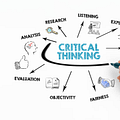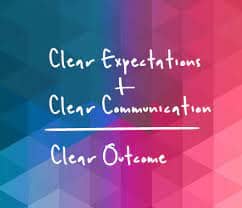Are your employees UNPRODUCTIVE and UNENGAGED?
Is there CONFUSION over what tasks each team member has to do?
Do your team members often FAIL DEADLINES ?
Do you often feel UNCERTAIN and ANXIOUS about how to get the project completed?
Do your team members DELIVER a low-quality output?
Do you often find your team members’ PERFORMANCE going down?
Do you face CONFLICTS at the workplace often?
Then in all probability, YOU ARE NOT setting clear expectations with your team members.
In a survey conducted by Gallup
-
Only 32% of the respondents said that their manager helped them set performance goals, and
-
Less than 40% felt that their manager supported them in setting work priorities.
It can be different in your case. You can be different from these managers by thinking and doing things differently than them.
When you play the role of a manager in your organization,
OR join a new workplace
OR a new project comes up
OR when a new employee joins a job
OR when there are some changes in the organization’s rules and regulations
OR when you notice employees not behaving in sync with the organization’s culture.
Setting CLEAR EXPECTATIONS with employees is a MUST for better employee engagement, trust, better outcomes, performance, lesser conflicts, and smooth functioning of the organization.
Would you like to Make A SMOOTH TRANSITION AND THRIVE CONFIDENTLY in your New Role ?
Get the FREE NEW MANAGERS GUIDE TO THRIVE CONFIDENTLY HERE

The post aims to help you learn a step-by-step process to set clear expectations with your employees, whatever the situation be, so that you can use their potential optimally, help them deliver better quality of output, work cohesively, and have a healthy workplace culture.
When I started as a senior coordinator, I got this wrong.
I did not realize the importance of setting clear expectations with teachers.
As a result, there would be delays, conflicts, and excuses from them.
And I as the leader would have to be answerable on their behalf.
It was TOUGH.
So to help you have a different experience, I am sharing a very simple and easy 8-step process to set clear expectations with employees.
1 CLEARLY DEFINE YOUR EXPECTATIONS
2 SET EXPECTATIONS AROUND THEIR STRENGTHS AND CAPABILITIES
3 COMMUNICATE YOUR EXPECTATIONS
4 HELP THEM UNDERSTAND WHY YOUR EXPECTATIONS ARE IMPORTANT
5 SEEK CLARIFICATION FROM EMPLOYEES.
6 GET COMMITMENT AND AGREEMENT SIGNED
7 PROVIDE THE NECESSARY RESOURCES
8 TAKE REGULAR ASSESSMENT
So let’s take a detailed look at each step one by one :
1 CLEARLY DEFINE YOUR EXPECTATIONS:
The first step in setting clear expectations begins with clearly defining your expectations.
Defining your expectations clearly will help you to articulate what you want from others very confidently.
Communicating your expectations to others clearly-
-
Reduces any ambiguity, minimizes stress and you feel you are well understood.
-
Helps you to use others’ potential fully well and ensures good outcomes
-
Helps you to build good relationships with your associates,
-
Creates a healthy work environment.
-
Develop healthy work habits in employees.
So here are a few things to keep in mind about setting clear expectations –
-
You must have a clear vision of how you want the result to be.
-
Define what you want.
-
Your message to your employees or direct reports must be clear, concise, transparent, and understandable.
4 .Get clear about how the employee will meet those expectations.
5 .What will you tell your first report about why you expect it from him?
6.You must let him know why you want him to do this.
7.The employee must know its importance as well as he must know why you have chosen him to do the work.
This step is an important step or foundational to other steps, if this is not strong the other steps will never fall in place.
It will be very wise to write what you want in a notepad first.
Writing down in a notepad will help you to see everything clearly and cover all the missing points.
2 SET EXPECTATIONS AROUND THEIR STRENGTHS AND CAPABILITIES.
The second most important step in setting clear expectations is to set expectations around the strength and capabilities of your employees /direct reports.
If the tasks are not assigned according to strengths and capabilities, then there are higher chances of disengagement, poor output and delay, and time loss.
They may fall out in between because they may not feel interested and motivated enough.
Take a moment and think, how do you feel when your boss does not give you tasks around your strengths and capabilities?
How does that feel?
I bet you do feel disenchanted and slog through it .
Am I right?
It is important to set expectations around the strengths and capabilities of your employees because if the task is assigned to them according to their strengths and capabilities, they will be more interested and engaged and the outcomes will be up to your expectations.
Some benefits of giving tasks to employees according to their strengths and capabilities are :
Employees will trust you as their manager.
It will help you develop engaged employees.
The Employees Will be more loyal to the organization.
It will help increase their retention.
A good way to know your employees’ strengths and capabilities are by doing one on ones with them.
You must ask questions about their strengths, preferences, skills, and abilities.
From step 1 make a list of tasks, and write the names of employees besides the task.
You will take a stronger second step by doing so.
So make it a habit to assign tasks to your employees according to their strengths and abilities.
3 COMMUNICATE YOUR EXPECTATIONS TO THE EMPLOYEES –
After you have finished with the first two steps, you are now ready to communicate your expectations to your employees/direct reports.
In this step, you will clear your thoughts.
Clarifying your thoughts will prevent you from looking confused, confident, or sounding vague in front of your employees.
It will prevent loss of time and any misunderstandings.
Some questions you can ask yourself on this are –
-
What is the task?
-
How should the expected outcome be?
-
When do you want it delivered?
-
What resources and help will the person need from your side?
-
What kind of challenges may arise and how to cope with them?
6 . What will be done in case a person fails deadlines or any kind of emergency arises?
-
Whom should they approach you when any unforeseen problem arises?
8 . When will they report progress to you?
A helpful strategy will be to write down the points you want to tell each of your employees in the notepad beside the task from the previous step.
Noting down what you want to tell each of your employees will help you see everything more clearly and know if you have missed out on any point.
This is an important step because writing down everything in the notepad will help you to see any ambiguities and complexities. This will help prevent vagueness, confidence, time loss, ambiguity, misunderstanding, confusion, and faltering.
Revise the page after you have finished writing down everything to add anything that comes to mind later.
Now find effective ways to communicate it -by speaking – holding a general meeting with the team and then one on one, writing -ie sending notes or messages.
See what parts will be communicated in speaking and what will be communicated in writing.
Schedule time to communicate.
An important point to note in this regard is to communicate it as clearly as possible in specific, simple, clear, concise, language Whether you speak or send written messages or notes.
4 HELP THEM UNDERSTAND WHY YOUR EXPECTATIONS ARE IMPORTANT.
As you communicate your expectations you need to let the direct reports know why this is expected of them and how it matters to the organization’s success as a whole.
It is very critical to let the employee know this because it builds a sense of responsibility in the employee and makes him feel trusted and valued.
This sense of responsibility, trust, and value will increase his engagement and ownership of the task and organization.
A very good way to tell them this is to make them imagine the outcomes of doing these actions -show the bigger picture of how the organization and employees will benefit on the whole so that they can understand clearly the importance of his contribution and act with more responsibility, be more accountable and deliver the outcomes on time.
Write a few points in your notepad before speaking to them, so that you do not falter in front of them.
So make sure you make them understand why these expectations are important for their individual as well as the organization’s success.
5 SEEK CLARIFICATION FROM EMPLOYEES
As soon as you finish speaking from your side or have completed your part, you need to confirm whether the employee has clearly understood what you wanted to convey.
This clears all doubts on both sides and creates more understanding, trust, and cooperation.
Some helpful questions to ask your employees are –
-
Have you understood clearly what I have said?
-
Does the work help you make the best use of your strengths?
-
Will the task be completed in the given time frame ?
4 .Is the workload too much?
5 . How can I help you? What resources will you need?
6 . What challenges do you see? What are the possible options to solve them?
-
How committed will you be in any challenging situation? Whose help will you seek?
8 . What will you do in case some emergency arises or you find yourself unable to meet the deadline? How will you inform me?
If you find from their responses that you are unreasonable to them, think about where you can downscale or downsize. Restructure things.
Do not dictate or be unreasonable with them.
Be collaborative and come to the best solutions with each other’s help and support.
This attitude will show your caring and supportive side and help you to strengthen your bonds and trust with your team.
Therefore always remember to cross-check and seek clarification from your team members.
6 CHECK THEIR COMMITMENT LEVEL AND GET AN AGREEMENT SIGNED .
Check the level of commitment with each employee.
A commitment score of 8 to 10 on a scale of 10 is the best. You must not agree on anything below 8.
After seeking clarity on commitment with employees, get an agreement signed with the due date written on it.
It can be a simple spreadsheet on google or word doc or paper, where you can write tasks in one column, name of the employee, signature, and date of start and completion.
It will be easy for you to track and he will take it seriously.
You can hold him accountable if he falls short in his performance.
To build a sense of ownership make sure you follow this.
You will be encouraging a good habit among your team members and contribute to better work culture.
7 PROVIDE THE NECESSARY RESOURCES
As soon as you finish with those above steps, It is time to help them with the necessary resources.
Apart from giving all the physical resources needed to complete the task, some other resources you can help them with are to set smart goals individually by conducting one on ones.
To set SMART GOALS, help them make a task list.
Set a deadline for it.
Brainstorm all challenges that can arise. Devise solutions for them.
Make an action plan and prioritize all the actions.
Make a schedule to complete those actions on time.
For complex tasks help them develop checklists.
Preparing them with physical resources, preparing them mentally, giving them emotional support by motivating them, giving positive feedback, and helping them solve challenges will bring amazing success to the task.
Your team will have more confidence in your leadership abilities.
You have to act as a facilitator in helping your employees achieve success.
So support them with all the resources and you will have done great work .
8 TAKE REGULAR ASSESSMENTS
Your responsibility is to see the project to the end of its completion.
To complete the project, here are –points to keep in mind.
Check-in with them regularly to know how they are doing. ‘
Take note of their attitude with others and keep correcting it when necessary.
Know where they are failing to perform, or are facing challenges Listen to them carefully. See where you can adjust your expectations.
Identify problems and lend support to them where needed – see if they need more resources, time, need help with systems, or shorten the process.
Identify what is not working and find alternative sources to help them. Take their help and devise solutions with them.
Have a flexible approach and restructure their workload, schedules, and routines as and when necessary,
Know where they are falling short and help them in finishing strong.
Remember you are a co-creator with them.
Facilitate, mentor, support, and trust them.
This will make them feel supported and taken care of.
You will be on your way to building a great team.
CONCLUSION
By now you must have understood the importance of setting clear expectations and how to set clear expectations with your employees step by step.
Setting clear expectations will help you build a great team culture and organizational culture. It will help you take one step to transition toward good team leadership.
A few things to keep in mind are to define your expectations, give tasks to employees according to their capabilities and strengths, seek clarification from them, help them with necessary resources, help them set SMART goals, support and encourage them and take feedback, assessment from time to time.
Here are some additional resources to help you further.
THE NEW MANAGERS GUIDE TO SET CLEAR EXPECTATIONS
13 TRANSPARENT WAYS TO SET EXPECTATIONS FOR EMPLOYEES
15 SMART STRATEGIES FOR SETTIGN CLEAR EMPLOYEE EXPECTATIONS
I hope you have found this post helpful.
What is your biggest takeaway from this post?
What are you missing out on?
Where do you falter the most?
If there is one thing they must do, What will you do right now?








